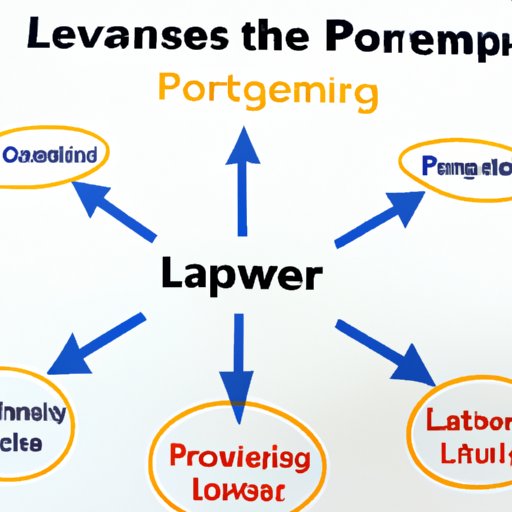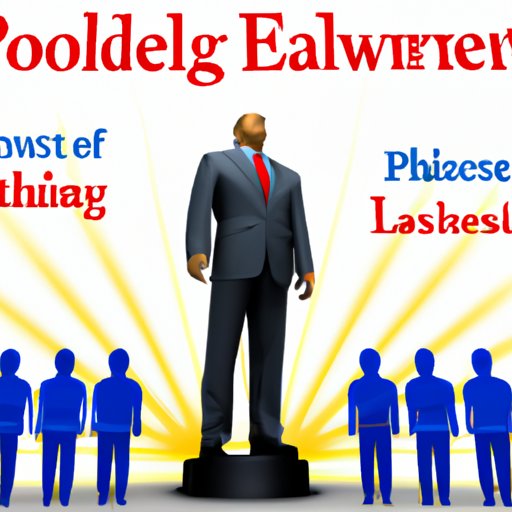Introduction
Leadership is a complex and multi-faceted concept that often involves the use of power to influence and motivate people. Power is an important element in leadership, as it enables leaders to achieve their goals and objectives. But what exactly is power in leadership?
Power can be defined as “the ability to influence or control the behavior of other individuals or groups.” In the context of leadership, power is the ability of a leader to influence and direct the actions of others in order to achieve desired results. Power can be derived from various sources, such as position, personal attributes, expertise, coercion, and respect.
In this article, we will explore the different types of power in leadership, how leaders use power to influence others, the benefits of having power, and the challenges of power. We will also examine the role of power in effective leadership.

Analyzing the Different Types of Power in Leadership
There are several different types of power in leadership. These include position power, personal power, expert power, coercive power, and referent power.
Position Power
Position power refers to the power of a leader’s formal authority. This type of power is derived from a leader’s title, rank, or office. It is based on the idea that people must obey those in authority, regardless of whether they agree with them or not. Position power is commonly used by leaders to delegate tasks, issue orders, and enforce rules and regulations.
Personal Power
Personal power refers to the power of a leader’s personality and charisma. It is based on the belief that people are more likely to follow someone who is seen as likable and trustworthy. Leaders with strong personal power are able to connect with their followers on an emotional level and inspire them to take action.
Expert Power
Expert power is the power of a leader’s knowledge and experience. It is based on the idea that people are more likely to follow someone who is seen as an expert in their field. Leaders with strong expert power are able to provide valuable advice and guidance to their followers.
Coercive Power
Coercive power is the power of fear and intimidation. It is based on the idea that people can be forced to do something through threats and punishment. Leaders with strong coercive power are able to manipulate their followers into taking certain actions.
Referent Power
Referent power is the power of admiration and respect. It is based on the idea that people are more likely to follow someone who is seen as admirable and inspiring. Leaders with strong referent power are able to create a sense of loyalty and commitment among their followers.

Examining How Leaders Use Power to Influence Others
Leaders use power to influence and motivate their followers in various ways. Below are some examples of how leaders use power to achieve desired outcomes.
Using Power to Lead by Example
Leaders can use their power to lead by example. They can demonstrate the behaviors and values they want their followers to emulate. For example, a leader can set an example of hard work and dedication, which can motivate their followers to work harder and be more productive.
Applying Power to Create Lasting Change
Leaders can use their power to create lasting change. They can implement policies and procedures that will have a positive impact on their organization. For example, a leader can introduce new training programs or incentive schemes that will help to improve employee performance.
Utilizing Power to Motivate and Inspire
Leaders can use their power to motivate and inspire their followers. They can recognize and reward employees for their efforts and accomplishments. For example, a leader can praise an employee for a job well done, which can encourage the employee to strive for even greater success.
Exploring the Benefits of Having Power in Leadership
Having power in leadership has numerous benefits. Below are some of the most common benefits of having power in leadership.
Increased Ability to Make Decisions
Leaders with power have the ability to make decisions quickly and effectively. They can make decisions without needing to consult with others or seek approval. According to a study conducted by Harvard Business School, “leaders with power are better able to make decisions that are beneficial for the organization.”
Increased Authority and Responsibility
Leaders with power have increased authority and responsibility. They are able to take charge of situations and make sure that tasks are completed in a timely manner. As stated in a study published in The Leadership Quarterly, “having power allows leaders to take initiative and be accountable for their actions.”
Improved Communication
Leaders with power have improved communication skills. They can communicate their ideas and plans clearly and effectively. According to a study conducted by Stanford University, “leaders with power are better able to communicate their vision and goals to their followers.”
Enhanced Problem-Solving Skills
Leaders with power have enhanced problem-solving skills. They can identify problems and develop solutions quickly and efficiently. According to a study published in The Journal of Applied Psychology, “leaders with power are better able to solve problems and come up with creative solutions.”
Investigating the Challenges of Power in Leadership
Having power in leadership also comes with certain challenges. Below are some of the most common challenges of having power in leadership.
Misuse of Power
Leaders who misuse their power can create a toxic environment within the organization. They can abuse their authority and take advantage of their position. According to a study conducted by the University of Pennsylvania, “misuse of power can lead to decreased employee morale and productivity.”
Difficulty in Delegating Tasks
Leaders with power may find it difficult to delegate tasks. They may feel the need to micromanage and take on more tasks than necessary. According to a study published in The Leadership Quarterly, “leaders with power often struggle to delegate tasks and trust their team members.”
Risk of Becoming Complacent
Leaders with power may become complacent and fail to challenge themselves. They may become too comfortable in their position and forget to push themselves to grow and improve. According to a study conducted by the University of Michigan, “leaders with power often fail to recognize the need for continual improvement and growth.”

Understanding the Role of Power in Effective Leadership
Power is an important element of effective leadership. However, it is important for leaders to understand the role of power in leadership and how to use it responsibly. Below are some tips for using power in leadership responsibly.
Importance of Empathy
Leaders should strive to be empathetic and understanding. They should listen to their followers and try to understand their perspectives. According to a study published in The Leadership Quarterly, “empathy is essential for effective leadership and helping followers reach their potential.”
Need for Balance
Leaders should strive to maintain a balance between using power and allowing their followers to take initiative. They should allow their followers to make decisions and take ownership of their work. According to a study conducted by Stanford University, “balance is key to creating a productive and successful team.”
Value of Transparency
Leaders should strive to be transparent and honest. They should be open and candid about their decisions and plans. According to a study published in The Journal of Applied Psychology, “transparency is essential for building trust and fostering collaboration.”
Conclusion
In conclusion, power is an important element in leadership. It enables leaders to influence and motivate their followers in order to achieve desired outcomes. There are several different types of power in leadership, including position power, personal power, expert power, coercive power, and referent power. Each type of power has its own strengths and weaknesses, and leaders should strive to use power responsibly. Leaders should also strive to maintain a balance between using power and allowing their followers to take initiative. Ultimately, power is an important tool for effective leadership and should be used wisely.
(Note: Is this article not meeting your expectations? Do you have knowledge or insights to share? Unlock new opportunities and expand your reach by joining our authors team. Click Registration to join us and share your expertise with our readers.)
